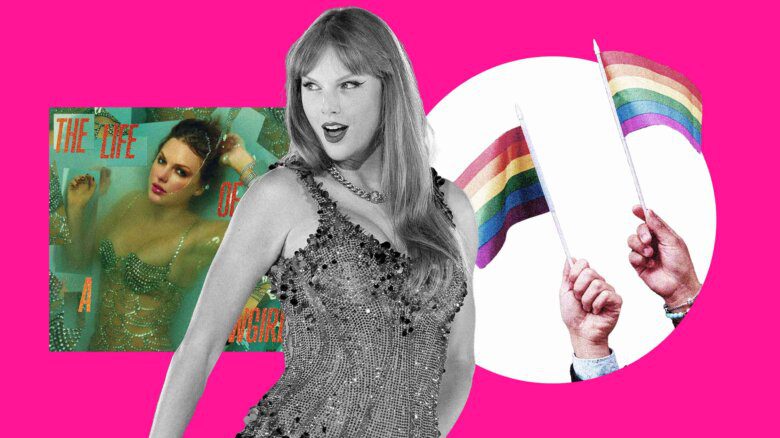On Lady Gaga’s remix album Dawn of Chromatica, Brazilian pop star and drag queen Pabllo Vittar transforms the heart-wrenching break-up anthem “Fun Tonight” into an upbeat, danceable song with a killer sax line and addictive rhythm. A sad song about the carelessness of Gaga’s ex-lover, and the singer’s complicated relationship with fame and hypervisibility is rendered by Vittar into a dramatic, fast-paced tune that embraces the potential of fun and joy in the midst of hardship and sadness. Described by Pitchfork as “one of the saddest songs in recent memory” turned “sun-kissed Brazilian street fair,” the remix is an example of the Brazilian genre of music called “brega,” an often misunderstood type of music that Vittar has spent his whole career trying to bring to the mainstream in Brazil and beyond. As the success of the “Fun Tonight” remix shows, Vittar is succeeding in refashioning brega on his own terms.
Historically, brega artists often poked fun at middle-class propriety and hypocrisy; for those in the know, there were many coded queer messages. Today, LGBTQ+ brega artists are thriving onstage and on the charts while singing explicity about queer sex. In “Amor de Que,” for example, Vittar sings to one of his lovers about his need for an open relationship and free love: “Look, I’m not being mean/ It’s just that there’s many handsome men in this city/ And I’m in my prime/ Better to regret it than ignore my urges.”
Another of my favourite brega artists is Aretuza Lovi, a drag queen from Cristalina, in the central state of Goiás. Lovi’s first claim to fame was her video for “Striptease,” which went viral in 2012. Lovi’s hit is an example of techno brega, a variation that mixes electric keyboard with the exaggerated lyrics and sentiments of brega. In 2016, Lovi released her brega-filled first album, Nudes, where her collaboration with Gloria Groove in the song “Catuaba” earned her another top hit. Like Vittar, Lovi defends brega’s style, relevance and musicality. “Brega has an aesthetic that has a lot of sparkle, choreographies, an emphasis on the romantic and on pleasure—it’s enchanting,” Lovi says. “I started making techno brega music when I was searching for my truth, because I loved this rhythm and I wanted to push it forward. So I think there is a connection there, you know, of energies: the costumes, the sparkle, the glamour and seeing artists [perform brega] is so incredible.”
The glamour of brega fashion is an important part of its appeal. Mixing fake high fashion with the colour and glitter of queer extravagance, brega reclaims and transforms notions of high-class living. Simply put, it’s what the working-class views as signifiers of wealth, but made with affordable clothing. “It’s a way the working classes can reclaim fashion,” says Eder Sedano, a history teacher and a PhD candidate at Pontifical Catholic University of São Paulo. “Most people can’t afford Gucci, but they can get fake Gucci clothes in Brás, and they try to copy that style, reappropriate it. But the elites classify that as brega, as an inferior kind of style.”
What drag queen performers like Lovi bring to contemporary brega feels revolutionary; a queer sexual revolution right in the middle of right-wing homophobic president Jair Bolsonaro’s Brazil. In her song “Nudes,” Lovi sings: “I send you nudes in the early hours/ I’m all alone at home, feeling naughty/ A million poses, sexy/ Turning you on on Snapchat.” Contemporary brega continues a tradition of challenging the traditional Brazilian family structure, mainstreaming dissenting bodies through pop culture. “We have to take ownership of our culture,” Lovi says. “I don’t like to define a genre of music as LGBTQI+ brega, because music is music, and music touches us. I think we can make any kind of music; music is a universal feeling. So we are making brega, there will be LGBTQI+ people making brega and we will dominate the charts.”
Brega music is a difficult genre to define, and even harder to explain to an Anglophone audience. The literal translation of the word “brega” is “tacky” or “corny,” but these translations don’t really capture the full dimensions of the genre, or the overdone production values of brega performances. Wikipedia intriguingly describes it as “popular romantic music with dramatic exaggeration or ingenuity, usually dealing with topics such as declarations of love, infidelity and love’s delusions.” Indeed, many brega numbers are about matters of the heart told with campy language and extravagant productions.
When the genre was first “discovered” by the Brazilian media in the 1980s, in the midst of Brazil’s military dictatorship (which ran from 1964 to 1985), the term “brega” was used as a put-down, a derogatory description of the music listened to by working-class people. Instead of relying on the flowery and poetic language used by mostly middle-class bossa nova artists at the time, brega artists got straight to the point, especially when it came to romance. It was also more popular in the northeast, a region that’s poorer and has a larger percentage of African-Brazilians than southern cities like Rio de Janeiro and São Paulo. The colourism and classism used against northeastern people by those in the south added to the stigma associated with brega—because the “underclasses” loved this music, it couldn’t possibly be considered good.
Middle-class journalists emphasized the lack of refinement and inferior musicality of brega. In the 1980s and ’90s, brega was often called “music for domestic workers,” characterized as the schmaltzy music that cleaners and cooks would play as they got on with their work. Since corniness and tackiness are subjective—as is classism—critics ended up generalizing a rich musical landscape. “The genre is incredibly rich in variety,” Sedano says. “I would define it as music by and for the working class.”
Sexual freedom and brega have always been intertwined. That history dates back to the Brazil’s millitary dictatorship, when queer and trans people were criminalized and brutalized for their sexual orientation and gender expression. “A Galeria do Amor” (“Love Gallery”), released in 1975 by the late Agnaldo Timóteo, lovingly describes the queer dating spot in São Paulo called Galeria Alaska, a locale dismissed in the Brazilian media as “dangerous and full of bad people.” For Timóteo, Galeria Alaska was a space for love, dating and pleasure: “The love gallery is/ A place for different emotions/ Where we understand each other/ Where we can love each other/ Freely.” Though only people who noticed the cruising at Galeria Alaska would recognize Timóteo’s references, this song marks an early intersection of queer allyship and the music of the Brazilian working class.
A similar phenomenon takes place in Odair José’s “Formas de Sentir” (“Ways of Feeling”), released in 1978 on his album Coisas Simples (Simple Things), a song that also expressed support for LGBTQ+ love: “I know you’re understood and you will understand me/ I accept and understand your ways of loving/ So, love, come out and consume/ The way you want to love.” According to Sedano, José was frequently a target of the military government’s censorship because his songs were explicitly about sex outside of marriage, supposedly inciting youth to have sex without forming heterosexual families. In “Formas de Sentir,” the sexual openness of brega and the persecution of queer people under a fascist state converged—it was censored by the government.
“Even with censorship, brega kept growing because people could relate to those songs,” Sedano says. “The ’70s were when the sexual revolution took place, but the middle class wouldn’t admit to the practice of sex because of the Catholic Church and the moralism of the bourgeois family. Brega artists came in to blow that open, to say, ‘No, it’s not just romantic love; people are having sex, real sex, heterosexual and homosexual sex.’”
Even as it grew more popular, brega didn’t gain more respect from the mainstream media. According to a 1988 rare academic paper written on the subject by Samuel Araújo for the journal Latin American Music Review, the Brazilian media became interested in the genre after Eduardo Dusek, a veteran musician and composer in the Brazilian pop music industry, released his 1984 album Brega-chique, Chique-brega. At the time “brega” did not appear in Portuguese dictionaries, so the media set about defining it. “The singer pointed out that although brega was an informal term applied to a whole body of mass-oriented popular music, its meaning had roots in broader socio-economic phenomena,” Araújo wrote. “Following the lead provided by Dusek, general newspapers and magazines began to ‘discover’ the brega universe, publishing interviews with and short stories about its more exposed representatives.”
To the surprise of middle- and upper-class newspaper readers, the unfamiliar names turned out to be bestselling recording artists, despite limited media coverage. Artists like Odair José, Amado Batista and Carlos Santos had been enjoying years of success without the spotlight of the media—it’s important to note that in the 1970s, ’80s and ’90s, the illiteracy rates in the northeast of Brazil, where many of these artist were popular, was high. In other words, newspaper media coverage was generally irrelevant to the working classes—and brega was proof that a whole world of music was being promoted outside of “traditional” avenues of communication.
Brega was also the term informally employed by music companies to describe these artists’ general style, even if the artists themselves did not identify their music nor their body of work as brega—for some, the stigma was too great. Vittar’s relationship with the genre has been one of reclamation: a queer working-class boy from the northeastern state of Maranhão, he grew up listening to the genre at home. Since the beginning of his career, Vittar has taken brega to the top of Brazilian charts and into LGBTQ+ club nights. “For gay kids who come from the countryside, and live such a difficult childhood, these songs helped me cope with all of that,” Vittar said in a recent interview about his latest album, Batidão Tropical.
In Batidão Tropical, Vittar pays homage to the brega artists who helped him survive as a queer kid: six tracks are re-recordings of famous songs from the 2000s. “Zap Zum” and “Bang Bang” are songs by the band Companhia do Calypso, which Vittar has said is one of his biggest influences. “Ânsia,” “Não é Papel de Homem,” “Apaixonada” and “Ultra Som” are also old brega songs that Vittar takes to the next level by performing them in drag. With this reinvention, Vittar pays homage to brega sounds of the north and the northeast of Brazil and takes ownership of the genre’s LGBTQ+ heritage. “From the very beginning, with my re-readings of their music, I hoped these bands would gain more space,” Vittar said in an interview with Diario de Pernambuco.
Rising star Danny Bond, who identifies as travesti (a transfeminine non-binary identity unique to Brazil) shows us exactly how LGBTQ+ artists are using brega to express their sexuality. In “Tcheca” (“Pussy”), which has over four million plays on YouTube, Bond plays with straight cisgender people’s fixation on genitalia, singing over heavy trumpets and a funky beat: “My name is Danny Bond and I have a pussy/ If you don’t believe me, I’ll show it to you/ But when I show it to you, you have to lick it.”
Bond is from the northeastern state of Alagoas, and she became interested in brega funk because she heard the rhythm a lot during her teenage years. “The LGBTQI+ community has always been present [in brega], but people ignored us,” Bond says. “Now we can create our own spaces on social media and digital platforms; there’s space for all of us and, more than ever, we are present everywhere. I believe brega has returned to popularity because of this new scene where we see artists from the north and northeast dominate the charts, and at the same time, making the LGBTQI+ movement visible.”
There are eerie parallels between the treatment of brega during the military dictatorship and the treatment of LGBTQ+ artists nowadays. Vittar, for example, is often a target of fake news and blatant censorship. “I think when liberties start being taken away, when there’s repression, people who have more liberal minds, more open minds, tend to go against the system,” Sedano says. “Pabllo Vittar, despite being an extremely talented musician—he has a wonderful voice—we can see how he is always marginalized, [the media] criticize him and diminish his artistic qualities.”
Bond, whose latest release is a hip-hop track called “Barbie,” draws special attention to the travestis and trans women who are making space for themselves in Brazil’s music scene. Citing her contemporaries Urias, Liniker, Majur, Linn da Quebrada, Pepita, Jup do Bairro and many others, Bond is excited about the future of pop music in her country, and the freedom of sexual and gender expression it might bring about. “In this moment in Brazil, it’s important for people like us to be associated with activism and pop culture, showing the next generation of artists that this space already exists, and that we will be here no matter what the politics in our country looks like,” she says. “And this year, we will topple this genocidal president.”
At its core, brega music is an over-the-top genre that refuses to be subtle about love, sex and sexuality. The extravagant and straight-to-the-point thrust of lyrics about sexual lives, combined with outrageously cheap and loud keyboard sounds over manic, danceable beats, is a direct challenge to Brazilian traditionalists and conservatives who would prefer the working classes and the queers to shut up altogether. Unfortunately for them, brega is here to stay—and if Vittar has his way, it will take over the world.
Pabllo Vittar is currently touring North America, finishing in NYC on May 1. Then he shifts to Europe through June.


 Why you can trust Xtra
Why you can trust Xtra


